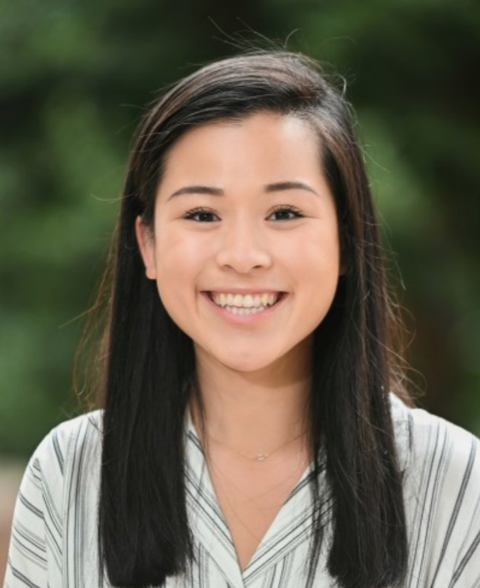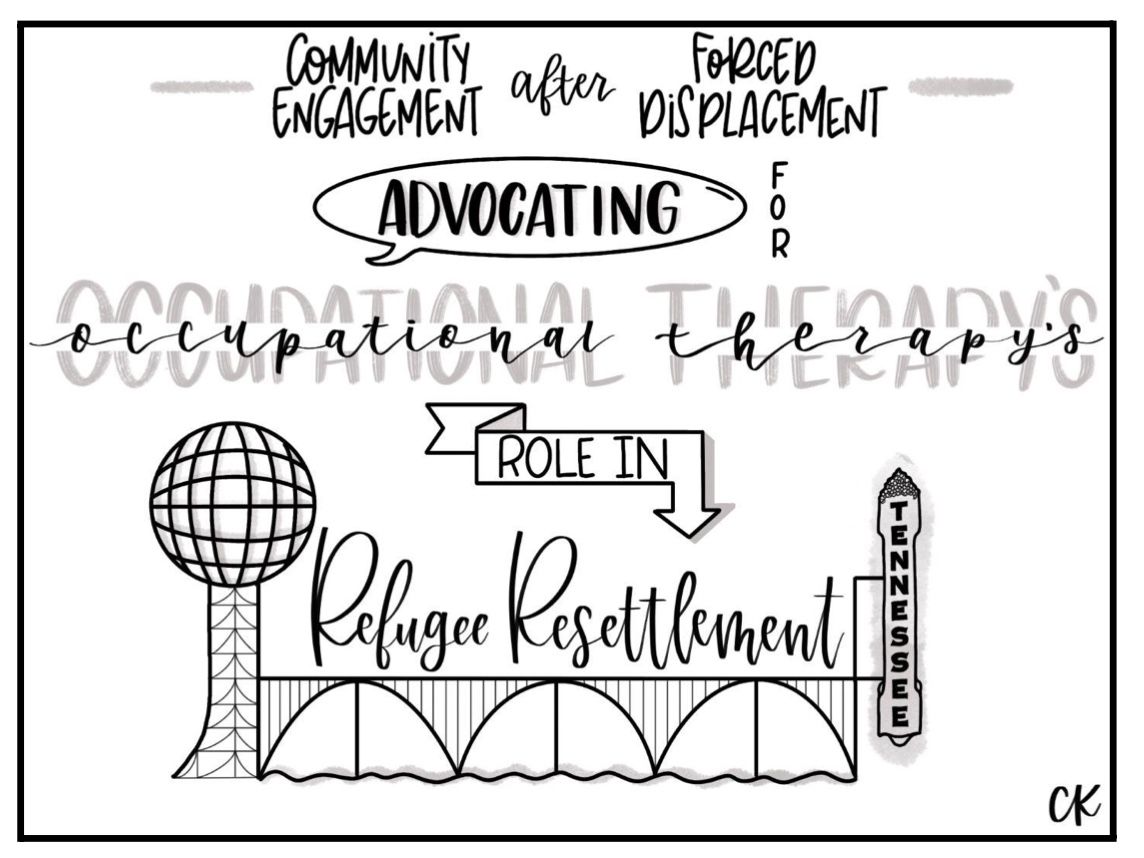
Welcome to guest blogger:
Cara Kingrea, OTS

Aspire OT is always excited to celebrate OTs, OTAs, and students who make an impact. Cara Kingrea is an occupational therapy student at University of Tennessee at Chattanooga.
Hi! My name is Cara, and I am an occupational therapy (OT) student at the University of Tennessee at Chattanooga (UTC). This semester, I completed my doctoral capstone at Bridge Refugee Services (BRS) in Knoxville, TN. You might be wondering, “What can occupational therapists do to help refugees?” Today, I’m going to briefly explain my capstone internship with Bridge and how OT can play a role in the field of refugee resettlement.
Before I touch on my capstone experience, I want to define what a refugee is. According to the United Nations High Commissioner for Refugees (UNHCR), a refugee is, “someone who has been forced to flee his or her country because of persecution, war, or violence. A refugee has a well-founded fear of persecution for reasons of race, religion, nationality, political opinion or membership in a particular social group. Most likely, they cannot return home or are afraid to do so,” (UNHCR, 2023, para 1). Often, refugees have to flee abruptly and leave behind their homes, loved ones, and meaningful occupations. Due to this forced displacement, refugees commonly face multiple forms of occupational injustice, such as:
● Occupational deprivation: when a person or group is unable to do what is necessary and meaningful in their lives due to reasons outside of their control (Scaffa et al., 2020).
● Occupational imbalance: when a person is underoccupied, overoccupied, or unoccupied due to a lack of accessibility in leisure or work opportunities (Scaffa et al., 2020).
● Occupational alienation: when a person feels isolated, powerless, a loss of control, and frustration due to events perceived as meaningless or stressful (Scaffa, 2020).
As OT students and practitioners, we know the therapeutic value occupational participation holds in promoting health and quality of life. Therefore, when individuals (such as refugees) are unable to engage in meaningful occupations and roles, their health and quality of life are negatively impacted (Kern et al., 2020).
Many refugees endure a difficult and prolonged migration, in addition to experiencing trauma, changing environments, and lack of choice while in their host country (i.e., detention centers, refugee camps, or the community) (Kern et al., 2020). If a refugee wants to resettle to a third country, such as the United States, that is an additional process of security which can add another one to two years (Kern et al., 2020). The U.S. Department of State (USDOS) reported that the process of displacement to resettlement takes, on average, 26 years (USDOS, n.d.a as cited in Kern et al., 2020). But problems are not automatically resolved once refugees are resettled. They often continue to experience isolation and occupational injustice as a result of language barriers, different cultural norms, and local stigma (Kern et al., 2020). This leads me to my experience with BRS.
One of my capstone projects was to conduct a literature review and needs assessment by interviewing Bridge clients to determine the long-term occupational needs of refugees. I completed 15 telephone interviews with Bridge clients that had been in the United States for at least one year and asked them questions according to the different domains of occupation (IADLs, Health Management, Education, Work, Social Participation). I also asked questions regarding Bridge services and other important topics such as immigration and English skills. I learned, firsthand, about the long-term barriers clients face in Knoxville. Some common themes I noticed were: immigration documentation, education, housing, transportation, adjusting to the American lifestyle, and learning the English language. Additionally, I learned about issues commonly seen amongst BRS’s clients in particular. Based on staff and case manager reports, clients face issues with substance use, negative impacts of trauma, lack of education regarding general health topics, and social isolation.
In collaboration with my site mentor and faculty mentor, we developed a plan to try and address some of these needs. During my capstone, I got the opportunity to develop a lifestyle management program manual to be implemented within their women’s sewing support group, initiated a Disability Training for volunteers and delivered a pilot presentation to staff, created various disability and wellness-related presentations to increase education and provide community resources for refugees, developed and recorded a mental health seminar for refugee clients, wrote and submitted a grant, and participated in community and pre-arrival tasks as a volunteer. All that to say, I got a lot of opportunities to gain experience in multiple areas of OT, such as program development, education, administration, and research. My overarching purpose for my capstone at BRS was advocating for clients to improve occupational engagement using evidence-based practices and OT principles.
Over the last decade, the number of individuals forcibly displaced has increased every year (UNHCR, 2022). By May 2022, there were more than 100 million people forcibly displaced due to the Russian invasion of Ukraine and other humanitarian crises in Central Africa, Afghanistan, Cuba, and beyond (UNHCR, 2022). Occupational therapists have a unique opportunity to help refugees during their resettlement process by integrating them into their new community and helping them resume their meaningful occupations and roles that may have been lost in transition. Refugees and other forcibly displaced persons deserve the right to participate in a variety of occupations that support their growth, are meaningful and satisfying, and consistent with their culture and beliefs (Hocking & Wilcock, 2020). The beautiful thing about the profession of OT is that it meets people where they are, sees the value in everyday activities, and facilitates engagement in occupations that are important, meaningful, and necessary.
Hi! My name is Cara, and I am an occupational therapy (OT) student at the University of Tennessee at Chattanooga (UTC). This semester, I completed my doctoral capstone at Bridge Refugee Services (BRS) in Knoxville, TN. You might be wondering, “What can occupational therapists do to help refugees?” Today, I’m going to briefly explain my capstone internship with Bridge and how OT can play a role in the field of refugee resettlement.
Before I touch on my capstone experience, I want to define what a refugee is. According to the United Nations High Commissioner for Refugees (UNHCR), a refugee is, “someone who has been forced to flee his or her country because of persecution, war, or violence. A refugee has a well-founded fear of persecution for reasons of race, religion, nationality, political opinion or membership in a particular social group. Most likely, they cannot return home or are afraid to do so,” (UNHCR, 2023, para 1). Often, refugees have to flee abruptly and leave behind their homes, loved ones, and meaningful occupations. Due to this forced displacement, refugees commonly face multiple forms of occupational injustice, such as:
● Occupational deprivation: when a person or group is unable to do what is necessary and meaningful in their lives due to reasons outside of their control (Scaffa et al., 2020).
● Occupational imbalance: when a person is underoccupied, overoccupied, or unoccupied due to a lack of accessibility in leisure or work opportunities (Scaffa et al., 2020).
● Occupational alienation: when a person feels isolated, powerless, a loss of control, and frustration due to events perceived as meaningless or stressful (Scaffa, 2020).
As OT students and practitioners, we know the therapeutic value occupational participation holds in promoting health and quality of life. Therefore, when individuals (such as refugees) are unable to engage in meaningful occupations and roles, their health and quality of life are negatively impacted (Kern et al., 2020).
Many refugees endure a difficult and prolonged migration, in addition to experiencing trauma, changing environments, and lack of choice while in their host country (i.e., detention centers, refugee camps, or the community) (Kern et al., 2020). If a refugee wants to resettle to a third country, such as the United States, that is an additional process of security which can add another one to two years (Kern et al., 2020). The U.S. Department of State (USDOS) reported that the process of displacement to resettlement takes, on average, 26 years (USDOS, n.d.a as cited in Kern et al., 2020). But problems are not automatically resolved once refugees are resettled. They often continue to experience isolation and occupational injustice as a result of language barriers, different cultural norms, and local stigma (Kern et al., 2020). This leads me to my experience with BRS.
One of my capstone projects was to conduct a literature review and needs assessment by interviewing Bridge clients to determine the long-term occupational needs of refugees. I completed 15 telephone interviews with Bridge clients that had been in the United States for at least one year and asked them questions according to the different domains of occupation (IADLs, Health Management, Education, Work, Social Participation). I also asked questions regarding Bridge services and other important topics such as immigration and English skills. I learned, firsthand, about the long-term barriers clients face in Knoxville. Some common themes I noticed were: immigration documentation, education, housing, transportation, adjusting to the American lifestyle, and learning the English language. Additionally, I learned about issues commonly seen amongst BRS’s clients in particular. Based on staff and case manager reports, clients face issues with substance use, negative impacts of trauma, lack of education regarding general health topics, and social isolation.
In collaboration with my site mentor and faculty mentor, we developed a plan to try and address some of these needs. During my capstone, I got the opportunity to develop a lifestyle management program manual to be implemented within their women’s sewing support group, initiated a Disability Training for volunteers and delivered a pilot presentation to staff, created various disability and wellness-related presentations to increase education and provide community resources for refugees, developed and recorded a mental health seminar for refugee clients, wrote and submitted a grant, and participated in community and pre-arrival tasks as a volunteer. All that to say, I got a lot of opportunities to gain experience in multiple areas of OT, such as program development, education, administration, and research. My overarching purpose for my capstone at BRS was advocating for clients to improve occupational engagement using evidence-based practices and OT principles.
So how does OT fit into this area of practice? Well, some of those common themes I mentioned earlier are definitely within OT’s scope of practice. For example, transportation and community mobility. When refugees arrive in the United States, they are having to navigate a whole new community and probably will not have a license or car for a while. That’s where an occupational therapist can come in and teach them how to navigate public transportation and then go out into the community and practice the real thing with them. Another example is housing and home maintenance. Prior to their arrival, some clients did not have access to appliances like we have in America. Occupational therapists can teach clients how to appropriately and safely use common kitchen appliances, such as the stove or oven. Other areas that are relevant to refugees and fall within OT’s scope of practice are finance management, shopping, social participation, health management (particularly developing adaptive coping strategies in response to trauma), and so much more!
Over the last decade, the number of individuals forcibly displaced has increased every year (UNHCR, 2022). By May 2022, there were more than 100 million people forcibly displaced due to the Russian invasion of Ukraine and other humanitarian crises in Central Africa, Afghanistan, Cuba, and beyond (UNHCR, 2022). Occupational therapists have a unique opportunity to help refugees during their resettlement process by integrating them into their new community and helping them resume their meaningful occupations and roles that may have been lost in transition. Refugees and other forcibly displaced persons deserve the right to participate in a variety of occupations that support their growth, are meaningful and satisfying, and consistent with their culture and beliefs (Hocking & Wilcock, 2020). The beautiful thing about the profession of OT is that it meets people where they are, sees the value in everyday activities, and facilitates engagement in occupations that are important, meaningful, and necessary.
References
Hocking, C., & Wilcock, A. A. (2020). Population health: An occupational perspective. In M. Scaffa & M. Reitz (Eds.), Occupational therapy in community and population health practice (3rd ed., pp. 59-72). F.A. Davis Company.
Kern, S. B., Reitz, S. M., Seruya, F. M., Silveira, J., Smith, B. C., Thompson, T., Kilkuskie, K., Santos, G., & Nguye, A. (2020). Promoting occupational participation in marginalized populations. In M. Scaffa & M. Reitz (Eds.), Occupational therapy in community and population health practice (3rd ed., pp. 457-487). F.A. Davis Company.
Scaffa, M. E. (2020). Community and population health concepts. In M. Scaffa & M. Reitz (Eds.), Occupational therapy in community and population health practice (3rd ed., pp. 22-37). F.A. Davis Company.
Scaffa, M. E., Fletcher, J., & Kilpatrick, J. F. (2020). Community reintegration services for military veterans. In M. Scaffa & M. Reitz (Eds.), Occupational therapy in community and population health practice (3rd ed., pp. 429–456). F.A. Davis Company.
United Nations High Commissioner for Refugees (UNHCR). (2022, June 16). UNHCR: Global displacement hits another record, capping decade-long rising trend. https://www.unhcr.org/en-us/news/press/2022/6/62a9d2b04/unhcr-global-displacement-hi ts-record-capping-decade-long-rising-trend.html
United Nations High Commissioner for Refugees (UNHCR). (2023). What is a refugee? https://www.unrefugees.org/refugee-facts/what-is-a-refugee/
Related Occupational Therapy Courses
Want more?
Our CEU courses will provide you with practical strategies you can take straight to your OT practice.
Aspire OT is a different kind of CEU company, owned by an OT & OTA.
Don't Miss A Thing!
Follow us on social media to stay up to date on all of our latest postings.
Join our newsletter
Get weekly updates on new blog posts, webinars, on-demand courses and more right in your mailbox.
Thank you!
Write your awesome label here.
Need a mentor?
Niccole and Kim would love to support you in your OT journey!
Just for OT Coaching is here to help you! Let Kim and Niccole share their experiences in clinical practice and professional leadership to help you achieve better outcomes.


